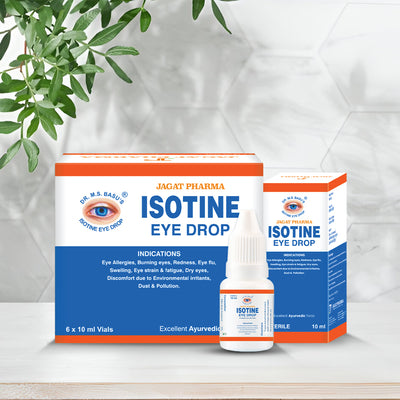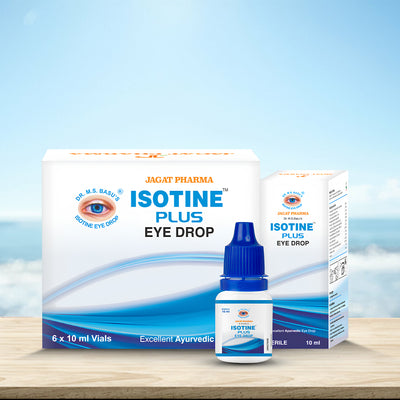
10 Easy Tips to Improve Eyesight Naturally
In today's digital age, where screens dominate our daily lives, maintaining good eyesight is more important than ever. The question arises, how to improve eyesight? There are several natural practices you can incorporate into your routine to promote clearer vision and keep your eyes healthy for years to come.
Tips to Improve Eyesight Naturally
Eat a Balanced Diet: A food rich in vegetables, fruits, and omega-3 fatty acids is essential for eye health. Foods like carrots, spinach, salmon, and nuts contain nutrients like vitamin A, C, E, and omega-3s, which support eye function and may help prevent age-related macular degeneration (AMD) and cataracts.
Stay Hydrated: Drinking plenty of water maintains the fluid balance in your eyes, preventing dryness and irritation. Aim for at least 8 glasses of water a day to keep your eyes hydrated and functioning optimally.
Take Breaks from Screens: Prolonged screen time leads to digital eye strain. Following the 20-20-20 rule helps maintain good eye health.
- The 20-20-20 rule suggests taking regular breaks during screen time.
- Every 20 minutes, take a 20-second break.
- Gaze at an object at least 20 feet away.
- This practice reduces eye strain and prevents discomfort.
- It allows your eyes to relax and refocus, promoting better visual health.
Practice Eye Exercises: Simple eye exercises can help strengthen eye muscles and improve focus. Try exercises like eye rolls, focusing on near and far objects, and palming (covering your eyes with your palms) to relax and rejuvenate your eyes.
Get Adequate Sleep: Quality sleep is necessary for eye health and overall well-being. Aim for 7-8 hours of sleep each night to rest and repair your eyes from the day's activities.
Protect Your Eyes from Ultraviolet Rays: Use sunglasses labeled with 100% UV protection to safeguard your eyes against sun damage. It lowers the risk of developing eye conditions like cataracts and age-related macular degeneration (AMD). By choosing sunglasses with adequate UV protection, you can enjoy outdoor activities while preserving your long-term eye health.
Maintain Proper Lighting: Ensure adequate lighting when reading or working to prevent eye strain. Avoid harsh overhead lighting and position your light source behind you or to the side for optimal illumination without glare.
Regular Eye Check-ups: Remember to schedule regular comprehensive eye exams with an optometrist or ophthalmologist. These exams can detect vision problems early on and help prevent serious eye conditions.
Staying Fit Contributes to Eye Health
Exercising regularly and maintaining a healthy weight support your eye health. One condition linked to lifestyle factors like obesity and poor blood sugar control is diabetic retinopathy. This condition arises from high levels of sugar in the bloodstream, which can damage the delicate blood vessels in the eyes.
Diabetic retinopathy affects the tiny arteries in the retina, the light-sensitive part at the back of the eye. Over time, these blood vessels may begin to leak blood and fluid into the eye, posing a serious risk to vision.
Maintaining a healthy weight and doing consistent exercise can diminish the chances of type 2 diabetes and its associated complications. Additionally, monitoring your blood sugar levels regularly is important for early detection and management of this condition, helping to preserve your vision in the long term.
Know Your Family Eye Health History
Recognizing that certain eye conditions have a genetic component is essential for proactive eye care. By being mindful of the eye conditions that affect your parents or grandparents, you can take preemptive measures to safeguard your vision.
Hereditary eye conditions encompass:
Glaucoma
Retinal degeneration
Age-related macular degeneration
Optic atrophy
Understanding your family's eye health history empowers you to take early preventive actions, preserving your vision for the future.
Exercises that Keeps Vision Healthy
- Eye Yoga: Practicing eye yoga involves moving your eyes in various directions, such as up, down, left, right, and in circles, to improve flexibility and circulation.
- Near-Far Focus: Alternate between focusing on objects close to you and those in the distance to exercise your eye muscles and improve focusing ability.
- Figure Eight Eye Movement: Visualize a giant figure eight in front of you and trace it with your eyes in a smooth and controlled manner to enhance eye coordination and tracking skills.
- Peripheral Vision Awareness: Sit comfortably and focus straight ahead while becoming aware of objects in your peripheral vision without moving your eyes. This exercise helps expand your field of vision.
- Blinking Exercises: Practice blinking regularly to keep your eyes moist and prevent dryness, especially during prolonged screen time.
- To enhance focus flexibility, extend your arm and hold a finger at a comfortable distance. Direct your gaze to your finger, then switch focus to an object in the distance. Alternate between the two several times. This exercise strengthens your ability to adjust focus, benefiting overall visual acuity.
Conclusion
Prioritizing eye health through simple lifestyle adjustments and proactive measures is paramount in today's digital era. By incorporating nutritious diets, regular exercise, adequate sleep, protective measures against UV rays, and mindful practices like the 20-20-20 rule and eye exercises, one can promote clearer vision and safeguard long-term eye health. Staying informed about familial eye health history further empowers individuals to take preemptive actions for preserving vision.


